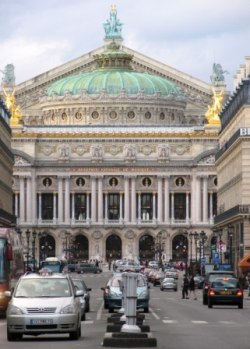Aidan Curran posted on February 23, 2010 18:00
Despite the impression we give in this blog, the most celebrated music venue in Paris is not La Flèche d'Or or La Maroquinerie. Though it may seem strange to us, those busloads of tourists much prefer to visit the Opéra.

The Opéra (right) is not the only opera house in Paris. Nearby is the Opéra Comique, a charming little roundhouse. Over at Bastille, a modern venue of that name is equally large but ugly like a financial services centre. The Opéra we're talking about is actually called the Opéra Garnier, named after its architect. When you say "the Opéra" in Paris, everyone assumes you mean this one.
In a city whose architectural landmarks know no restraint, the Opéra is particularly over-the-top - a Venn diagram where 'architecture' overlaps with 'wedding-cake'. (In fact, there's a small chocolate cake called an Opéra.) Seen when you're coming up from the metro station of the same name, it looms like an airship. As with many famous Paris buildings, only by walking around it can you appreciate how enormous it is. Commissioned in the mid-19th century, it symbolises the ostentatious wealth of Paris under the restored Empire. The surrounding streets, with their lines of black balcony railings, were designed by Baron Haussmann, architect of the quintessential Paris avenues and boulevards.
Paris in the time of Charles Garnier and Haussman was turbulent, to say the least. (The Avenue de l'Opéra - long, wide and slashed by narrow, angled streets - was specifically designed so that the army could outflank any barricade in the area.) By the time the Opéra was finally completed, in 1875, the Second Empire of Louis Napoléon had been ousted by the Commune, the Prussians and the Third Republic. To attend performances in the Opéra he built, Garnier had to buy a ticket.
Invited by a friend with a spare ticket to sell, your correspondent went to the Opéra recently.
It may be hard to believe, but the inside is even more extravagant than the outside. Marble, gold leaf, hardwood, chandeliers - we found it far more impressive than the chateau of Versailles. The concert hall features Chagall's famous painted ceiling - renowned composers and their works represented in daubs of bright, childlike colour. Most exciting of all is the breathtaking view from the front balcony down the avenue, which makes you feel like a lord or lady looking down on the poor people below. No wonder the people revolted.
These days, ordinary citizens can come to the Opéra too - there are some tickets available for 10 euros. However, you actually don't see the show from those seats. Of the Opéra's 2,500 or so seats, many of them only have partial views from behind pillars or balcony edges. Those ten euro seats are at the back of a box - but the people who buy them mostly come just for the music or for the experience of being inside the Opéra. Our seats were at the front of a box, but we still only saw about 70% of the stage.
We saw 'La Dame Aux Camélias', a recent ballet made from an Alexandre Dumas short story and compositions by Chopin. (France's other favourite adopted Pole besides Marie Curie, Chopin was born exactly two hundred years ago. He's buried in Père Lachaise - except for his heart, which is in a church in Warsaw.) Those ten euro punters got lucky - the orchestra's pianist gave a marvellous show. For the rest of us, the on-stage show was extravagantly beautiful.
Only by seeing live ballet do you realise how the apparent grace of the dancers hides the incredible physical demands on them. Walk on your tiptoes for five minutes and see how you feel; now imagine dancing, spinning and landing on them for an hour. Your marathon-running blogger marvels (and winces) at the strain a top ballerina puts on every tendon and ligament in her legs. Our trip to the Opéra was very educational indeed.
The Opéra in Paris is most famous because of a musical from London. Yes, a lot of those tourists are actually fans of Andrew Lloyd Webber's 'The Phantom Of The Opera', based on Gaston Leroux's classic French novel about a disfigured man lurking in and under this same venue. (Your correspondent didn't see any phantoms at the Opéra that night. West End musicals - don't trust 'em!) So, here are Sarah Brightman and Steve Harley with its appallingly naff theme song - just for the hilariously awful video. Look out, mullety man!
More ...
[Read More...]